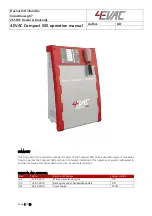
P3V Veterinary Digital Ultrasonic Diagnostic Imaging System User Manual
- 4
-
19. The use of transducer and connecting cable not supplied by the manufacturer may
result in increased emissions or decreased immunity of the equipment.
20. No modification of this equipment is allowed.
21. The system should be maintained regularly, at least annually, by a qualified
technician who has adequate training, knowledge and experience. That person
should be familiar with the Service Manual, available from representative of the
manufacturer.
22. The appliance coupler or mains plug is used as isolation means from supply mains.
Position the system in a location where the operator can easily access the
disconnection device.
23. Do not use a battery that leaks, emits an odor, appears deformed, or discolored.
Immediately replace it with a new manufacturer -supplied battery and dispose of the
old battery according to local regulations. Replace a battery that has reached the end
of its service life.
1.5.2. Biohazard Considerations
WARNING
1. This device is not suitable for intracardiac use or direct cardiac contact.
2. The manufacturer makes every effort to manufacture safe and effective probes. You
must take all necessary precautions to eliminate the possibility of exposing patients,
operators, or third parties to hazardous or infectious materials. These precautions
should be considered in the use of any application that may indicate the need for
such care, and during endocavity scanning.
Ultrasound may be harmful to human body. This device should be used for valid reasons,
for the shortest period of time, and at the lowest mechanical and thermal indices necessary to
produce clinically acceptable images. According to the ALARA (As Low As Reasonably
Achievable) principles, acoustic output should be set to the lowest level required to satisfactorily
perform the examination. Long time exposure should be avoided. For the parameters of sound
output, please refer to appendix II.
The P3V complies with the requirements of applicable International Electrotechnical
Commission (IEC) standards in terms of safety and acoustic output levels.













































